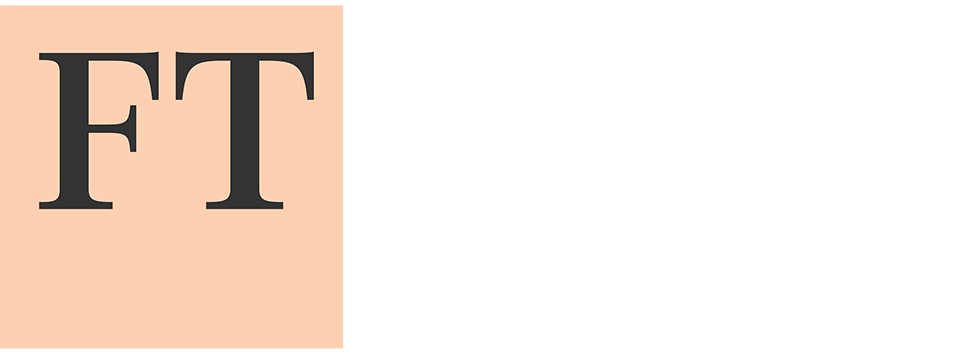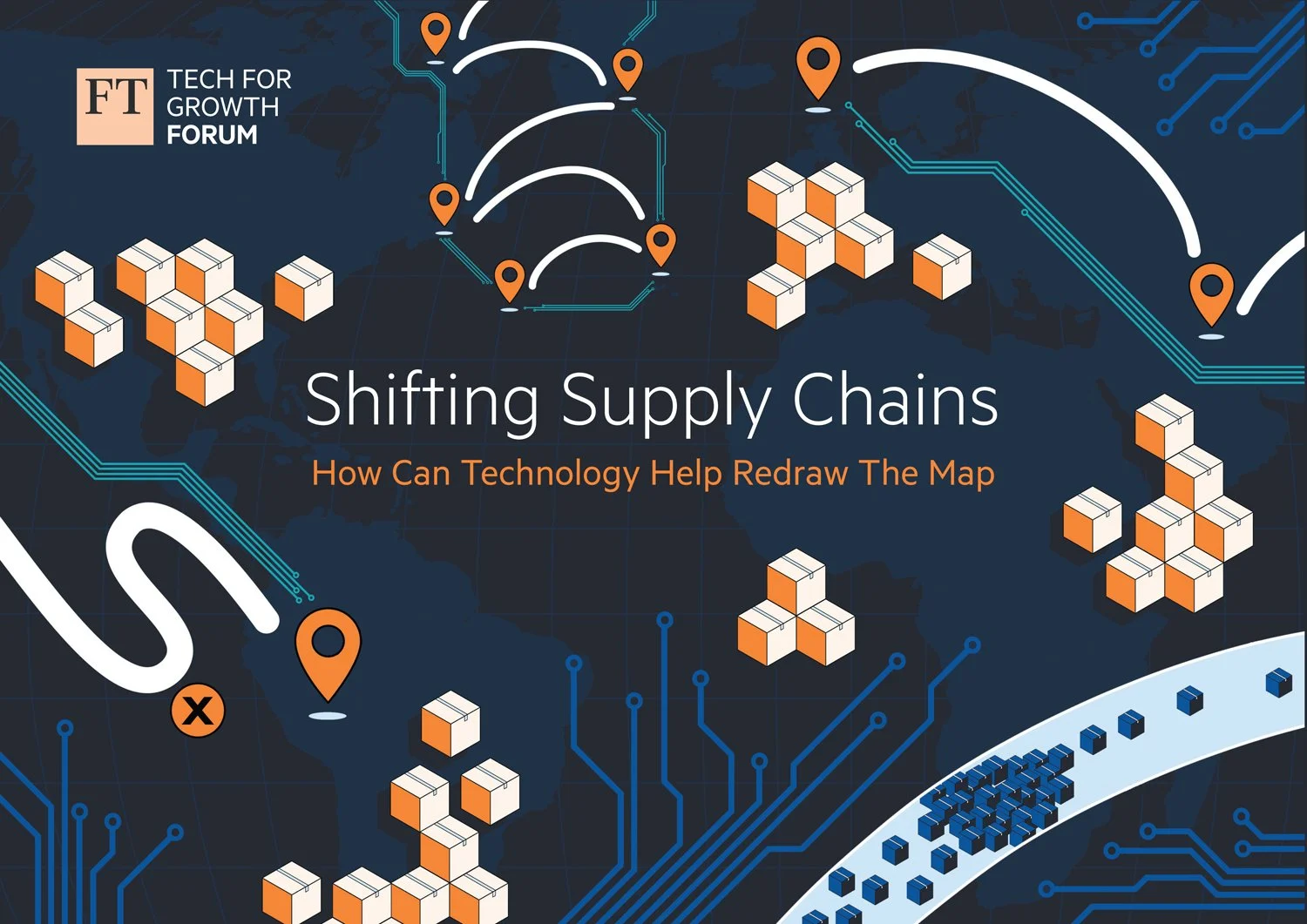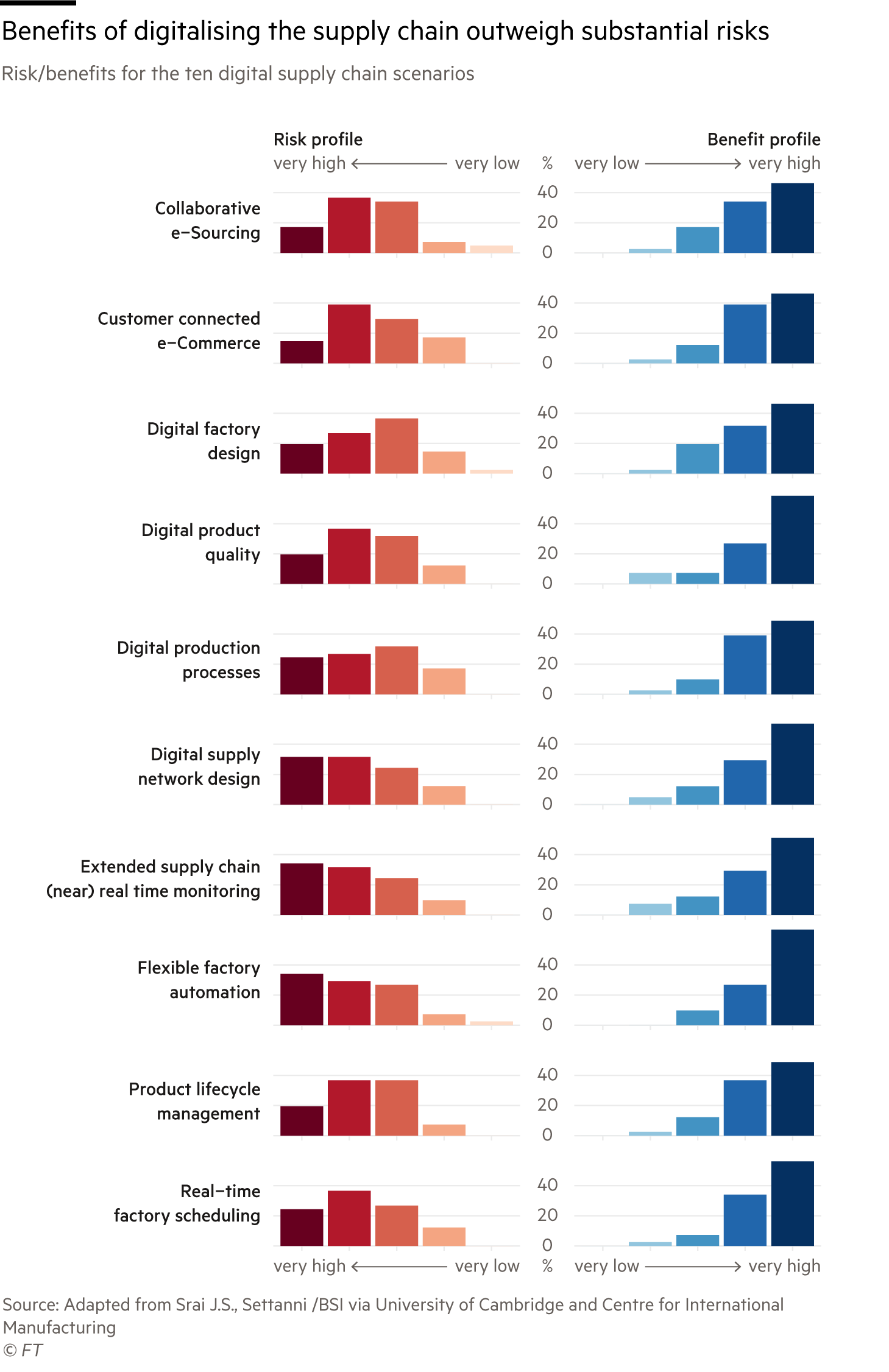The FT Tech for Growth Forum is supported by
Foreword
Jonathan Derbyshire, Tech for Growth Forum Editor, Financial Times
A combination of the Covid-19 pandemic and growing geopolitical tensions has placed the just-in-time supply chain model, on which the past three decades of globalisation have been built, under unprecedented strain. This poses significant challenges to governments and policymakers, and to companies and chief executives.
No one can predict where the next destabilising shock will come from, of course, or in what ways the shape and distribution of global trade will change in the years to come. But there remains a great deal that corporate leaders can do to protect their supply chains from disruption.
This report from the FT Tech for Growth Forum explores some of the technological solutions available to them - from machine learning, through the digitalisation of procurement and fulfilment, to the use of the internet of things in the transporting of goods and deploying robots to enhance stock and warehouse management.
None of these technologies is a ‘silver bullet’ - global risk is too protean for that. But what can be said with certainty is that companies which do not invest in technology to cope with increasing complexity of supply chains will put themselves at a significant disadvantage.
Shifting Supply Chains
Technology can help with the challenges that face supply chains, but companies must know which problems they want to solve first, writes Lucy Colback
Supply chains under pressure
Supply chains face a rethink. Geopolitical fissures have disabled the just-in-time model, unwinding decades of globalisation. The dangers of overreliance on one large manufacturing base, China, has been exposed by the pandemic. Early on in the Covid outbreak, Fortune observed that 94 per cent of Fortune 1000 companies had experienced supply chain disruption.
Added to this, many companies in the UK have been hamstrung by Brexit. Multinationals had the resources to prepare for Britain’s departure from the EU and, in critical sectors such as pharmaceuticals, many received government help to increase inventories and set up alternative sourcing. Small and medium businesses without financial clout, however, have been severely affected.
Other countries did not have the UK’s additional impediment but they still experienced shipment delays. The August 2022 Global Supply Chain Pressure Index collated by the Federal Reserve Bank of New York showed that while delivery times had reduced in the previous four months, pressure was still high. This left the chain vulnerable to any disruption or even to fluctuations in seasonal demand.
Against these stresses, consumers continue to expect greater choice delivered quickly, cheaply and, increasingly, more sustainably. Even as disruptions continued, global trade for 2021 reached a record high in value, according to the UN Conference on Trade and Development. Suppliers should aim to meet the challenges that accompany this demand. To do so effectively, factors such as resilience, reliability and flexibility of the supply chain should be treated as more important than cost and efficiency.
Visibility is the key
Visibility can help to solve problems. An accurate overview of the chain will mean that disruptions can be identified and dealt with. This will give a degree of resilience, says ManMohan Sodhi, professor of operations and supply chain management at Bayes Business School London. At the consumer end of the chain, traceability can fulfil shoppers’ demands for sustainability.
Most companies recognise the need for better visibility but only a few can achieve it. In 2020, SupplyChainBrain, the supply chain management information resource, said most enterprises could see just 20 per cent of their chains – it recommends 70 to 90 per cent. SupplyChainBrain says digitisation to enable greater visibility is "no longer optional" if we are to avoid severe business consequences.
For the best results, supply chains should be digitally integrated from the most upstream commodity and component supplier to the final customer. Manual inputs would be turned into digital data that is consolidated, legible and visible throughout the system.
The costs of not embracing digitisation are considerable, according to a study in 2021. It said the average annual cost to an organisation of manually entering data averaged $1mn in the organisations it polled, while more than $600,000 was spent in manual entry of supplier invoices.
The importance of a digital supply chain strategy is well understood but, due to the complexity, most companies struggle with implementation.
Transmetrics, an AI logistics software provider, says the logistics sector is notorious for its heavy use of manual processes and large volume of disparate data that can be costly to centralise. The result is that holistic digital integration is extremely challenging.
Supply chains are also disrupted by technology silos between and within companies, as well as the lack of standardisation in data — a barrier that organisations including GS1, the champion of the barcode, are working to dismantle.
Adopting technological solutions
Many companies are eager to deploy technology-enabled solutions. A survey conducted in 2022 by SAP, the software solution provider, found that within the next year or two, 70 per cent of UK businesses plan to adopt the latest technology to try to overcome supply chain challenges.
Older technology is already adding value. Some solutions that have evolved over decades, such as robotics and supply chain optimisation, have lowered costs and improved efficiency. Systems based on legacy software have emerged to improve supply chain visibility. Wincanton, the supply chain solution provider, has developed an application that applies new modules to existing technology. Its system can track goods from order placement to arrival at a consolidation centre. This "control tower" capability is still being developed and some manual elements remain.
How a company approaches digital transformation is critical to success. Change should be viewed as an opportunity rather than a threat — and businesses must be prepared to fail as they learn. Michael Feindt, an adviser at Blue Yonder, the specialist in intelligent supply chains, says that while a move towards greater use of technology can be hampered by fear, this is less prevalent in South America and Africa – perhaps because there is more to gain in less developed markets.
A supply chain upgrade should be a stepped process rather than a simultaneous, wholescale overhaul. Adoption of new technologies, such as blockchain, artificial intelligence (AI) and the internet of things (IoT), should be incremental, not least because these are still poorly understood and sometimes seen as a panacea, which they are not. Early adopters will undoubtedly experience disappointment.
Most importantly, as Sodhi's research emphasises, companies must first identify the problems they face and then, second, clarify their strategic goals.
Technology will certainly help companies to become more adaptable and flexible, reduce costs and errors, optimise asset usage and speed up processes and communication. It will free workers from repetitive tasks to roles that require judgment and experience. Yet only when the right solutions are applied to defined problems can supply-chain technologies achieve any of the many aims.
"Whatever the prioritised list of needs or expected benefits you seek and whatever your organisational constraints … you bring that to the vendor and ask them which they can or cannot do", Sodhi says. He emphasises that the onus is on suppliers to identify solutions and, if necessary, to undertake their own pilot schemes to test nascent technology.
Having the right organisational structure can improve outcomes and prevent a failure of experimental technology from going on to affect the entire business. Paul Durkin, chief customer and innovation officer at Wincanton, says his company has improved by splitting its technology function in two. One part addresses the challenges that face the existing business while the second identifies opportunities and products based on emerging technologies. He says "this creates bandwidth" for product development without neglecting current projects, thus creating more solutions for customers’ problems.
The two parts come under one division and they unite to implement viable solutions. "There is no technology we have taken that hasn't met expectations, but there are technologies that we have to be ready to consume as an organisation," Durkin says. He adds that people are key. "In some cases [we may be] ready from a technology point of view; in [other] cases that might be from a people point of view. It's the combination of people and technology that make it work."
Understanding the limitations
Even once a technology solution has been identified as the right one, it is important to understand its capabilities. Feindt says: "Data-driven AI can help [in the] short term but for long term planning it gets more difficult. That is because the [likelihood of] unprecedented events becomes larger with longer time frames." In other words, AI cannot overcome the fundamentals of statistics nor predict the unpredictable.
"Once an event has happened, software can help [you] adapt fast,” Feindt says. “For instance it can predict how consumer behaviour will develop and the necessary execution." It can also rapidly assemble data about current circumstances, such as blockages at ports, helping companies to act quickly to find alternative products or suppliers.
In the early days of the pandemic, machine learning (ML) could outperform humans. As the latest data came in, ML made use of them to come up with the best response. ML quickly learnt that this was not at all like a holiday period.
Some customers initially feared that their software would be unable to cope with the unprecedented situations caused by the pandemic. Machine, however, turned out to be far faster than man in understanding and reacting to the flood of data. AI and ML also measured predictions against actual outcomes, learning as it went.
While unpredictable events are inevitable, technology can devise scenario planning to help supply chains withstand shocks. It will optimise inventory management by incorporating levels of uncertainty and can help organisations reach strategic goals, for example, minimising wastage.
Ultimately, networks will be able to be envisioned, designed and tested for resilience through scenarios where parts of the chain are "attacked" and contingencies brought into play. This could also help with the relocation of supply chains, such as from China to other parts of Asia, with systems optimised for site location, capacity, inventory management and customer response.
To outline some of the technologies that can make a difference, this report looks at the strands of a typical supply chain to show which solutions add value and where, and which hold promise for the future.
Companies should focus on what technologies do, not what they are, advises Cambridge University's Centre for International Manufacturing. Echoing Sodhi, it says that a business’s strategic objectives — better delivery, better products, increased efficiency — should drive decisions on which part of the supply chain needs investment and the technology to be deployed.
IBA Group, the outsourcing and software services company, says it can be better and less stressful for management, and therefore more successful, to upgrade facilities than to switch to an entirely new infrastructure.
Procurement and fulfilment
Procurement and fulfilment are entwined even though they are at opposite ends of the chain. Based on actual orders or predictions about orders, the former sources materials and goods to ensure that demand is satisfied through fulfilment. The more digitised a company's procurement data, the better it can integrate with suppliers. If other suppliers are similarly enabled, the improved connectivity will boost visibility and responsiveness along the chain.
Software solutions
The amount of data available for consumer behaviour is growing fast. According to an Ericsson report this year, total global mobile data traffic reached 67 exabytes a month at the end of 2021. This is expected to more than quadruple to 282EB a month in 2027.
With the integration of information from suppliers and customers, AI and ML can provide demand forecasts and statistical analysis faster and more accurately than humans. Higher demand for a new type of product in a region can be identified early, which provides insights that can then be applied predictively to neighbouring markets. Data analysis can help to manage price movements and find cheaper sources.
Supply chain planning is not new but a digitised system will allow more extensive scenario modelling. This will help companies work out how best to continue should part of a chain break, or to identify when alternative suppliers may be needed. As with visibility, such planning improves resilience. Companies that hold good quality data will have a significant advantage.
The resilience of sourcing will be further enhanced when impending supply failures can be identified through automated monitoring that uses natural language processing. This could involve, for instance, the use of information gleaned from the web about extreme weather or political events. To some extent, this is already provided by "control towers". These are less automated cloud-based data repositories that rely on both manual and automated sources to give companies an improved view of their chains. Control towers can, for example, give early warning of when an external shock is about to trouble a supplier.
While control towers are already in use, continued manual inputs, data quality and the security of transfer between companies stand in the way of full automation. They are expected to be a strong growth area: the control tower market was worth $6.5bn in 2021, according to Grand View Research, and this valuation is predicted to grow at a compounded rate of 20 per cent a year between 2022 and 2030.
Automated analysis that uses natural language processing and ML can also optimise supplier contracts, provide items to review or action and ensure that procurement terms are in alignment and standardised. Similarly, automation of repetitive tasks such as invoicing can reduce human error and speed up processing times. ML can also analyse invoices to prevent fraud.
Production
The efficient production of goods relies on a glitch-free manufacturing process. Equipment failure, poor management of input materials and bad scheduling all cost time and money. Solutions in this area are intended to ensure that downtime is minimised and the use of time and materials is optimised.
Sensors can monitor anything from equipment function to product flow and help companies select more efficient production schedules. Combined with ML, sensors can predict the need for equipment maintenance and say when a particular piece is likely to fail. Smart sensors can spot quality issues based on data inconsistencies and decide when to call for human oversight.
Want the best factory layout? Digital twinning can help. This is used to create a virtual replica of existing plants and work sites. It can provide insight into the best design, for example when new machines are being installed.
One of the more mature technologies available for use in supply chains is robotics. Functionality has become increasingly sophisticated and the use of robots has spread far beyond its traditional heartland in the automotive sector. Data from the Association for Advancing Automation show that in 2021, sales of robots rose 28 per cent year on year to $2bn. This was triggered by a shortage of workers during the pandemic and was 14 per cent above the 2017 sales record. Non-automotive sectors represented 58 per cent of the total.
3D printing is useful for companies that produce work in small-scale batches near to their end markets. This is becoming more common in high-precision, low-volume industries such as customised medical devices, aerospace and aviation as well as those producing prototypes and spare parts.
Transport
While the IoT grows bigger and stronger by the day, systems built on the more mature RFID technology (radio frequency identification) can offer near real-time monitoring of goods in transit. This allows accurate scheduling of handling and delivery and the most efficient use of fleets of lorries or vans. For refrigerated items, tracking enhances quality control by giving near-continuous temperature readings. In April 2022 Hapag-Lloyd said that all of its standard containers would have trackers within months, offering greater visibility of this part of the chain.
Various software providers now offer control towers, which combine third party data and algorithms to solve transport problems. These can be especially helpful when delays occur: storms can be tracked and routes altered almost straight away. When dealing with mundane events such as traffic jams, technology can identify alternative routes far faster than people can.
One drawback, however, is where a system still relies on data that is manually input. Currently when disasters affect trade arteries – the blocking of the Suez Canal by a container ship in 2021 is one example – it can take longer for companies to reconfigure schedules if their processes are not fully automated. The more data a system has, the faster it can optimise alternative plans. At some stage, natural language processing and standardised announcements — of changes to Covid regulations, for instance — should facilitate more automated data collection.
AI can speed up mundane tasks such as choosing a carrier. It can assist logistics planners by narrowing down possible routes. The process is similar to that of an individual consumer who uses Google Flights to select a plane ticket. Predictive algorithms can also make sure that assets, for example containers, are in the right place at the right time. AI improves data analytics, capacity estimation and network analysis.
Digital twinning uses AI and the IoT to make transportation more efficient. In the Port of Rotterdam, for instance, sensors in a digital twin help to plan mooring and unloading schedules, taking into account the state of the tide and weight of cargoes. In the long run, DHL envisages that digital twins of entire routes will be possible, all using real time information. This will make autonomous deliveries more feasible.
Blockchain is said to have the potential to revolutionise much of the supply chain by providing transaction verification. Its promise to solve border logjams caused by Brexit have yet to materialise, however, and with limited evidence of its value or applications, any wide scale adoption should be treated as speculative.
Stock and warehouse management
Warehouses operated by Ocado, the grocery technology company, show how end to end integration can add value. Systems based on its Smart Platform – which was developed in-house to meet its own business needs – are sold to grocery companies worldwide.
Robots have added value to this part of the chain for decades and they have become increasingly sophisticated. Robots enabled with sensors, ML and AI can load trucks and pallets and move boxes. Ocado's state of the art warehouses reduce downtime, as their robots monitor their own "health". At Amazon, robots do everything from lifting heavy loads to fast and accurate picking and packing.
Stock levels are based on actual orders and predicted demand – and this is where AI can bring savings. Historical data and pattern analysis have helped Ocado to reduce food wastage. It is down from the industry average of two to three per cent to 0.6 per cent.
The ‘last mile’ and the customer
Last mile delivery can make or break customer satisfaction levels for a consumer-facing company. Besides the technologies already outlined, which help to predict demand and ensure that goods are available for delivery, software can optimise route planning as customer orders are received. For the past few years street robots have delivered fast food in London and other European cities. We can expect to see more autonomous vehicles and drones being used within a few years.
Fully digitised supply chains not only enable efficiencies in existing businesses, they can also enhance revenues by focusing on what customers may need or wish to buy. Within procurement, ML and algorithms can make use of customer buying patterns and help to sell more products. Digital sales channels are no longer simply nice to have, they are essential for companies to reach digitally savvy consumers and tailor products for them.
As demand increases for products whose sustainability is verified, traceability will give an edge to the consumer-facing companies that are among the first adopters.
Risks to watch for
Conclusion
Technology can help with the challenges that face supply chains. For greater adoption to be a success, however, companies must know which problems they want to solve. They must recognise that any solution is simply a tool that must be applied and used correctly by skilled people trained in its use.
If there are problems in a supply chain, these need to be identified and addressed as early as possible. Even with the best technology, there is no substitute for communication and transparency. Early intervention can save companies’ relationships with their customers.






